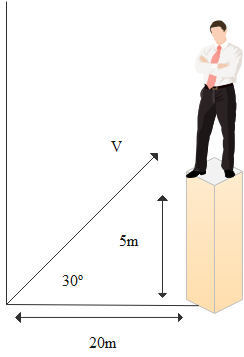
A ball is thrown upward at an angle of ${{30}^{{}^\circ }}$with the horizontal and lands on the top edge of a building that is 20 m away. The top edge is 5 m above the throwing point. The initial point of the ball in metre/ second is (take g = $10m/{{s}^{2}}$):
(A) $u=40\sqrt{\dfrac{(4+\sqrt{3})}{13\sqrt[{}]{3}}}m/s$
(B) $u=40\sqrt{\dfrac{(4-\sqrt{3})}{13\sqrt[{}]{3}}}m/s$
(C) $u=40\sqrt{\dfrac{(4+\sqrt{3})}{13}}m/s$
(D) $u=40\dfrac{40}{\sqrt{\sqrt{3}}(4+\sqrt{3})}m/s$
Answer
221.7k+ views
Hint: We should know that velocity is defined as the rate change of displacement per unit time. Speed in a specific direction is also known as velocity. Velocity is equal to displacement divided by time. Speed, being a scalar quantity, is the rate at which an object covers distance. The average speed is the distance which is a scalar quantity per time ratio. On the other hand, velocity is a vector quantity; it is direction-aware. An object which moves in the negative direction has a negative velocity. If the object is slowing down then its acceleration vector is directed in the opposite direction as its motion in this case. Based on this we have to solve this question.
Complete step by step answer
The diagram for this question is given by:

Let us first write the quantities that are mentioned in the question:
Horizontal angle is given as$=30^{\circ}$
Horizontal distance is given as $=20 \mathrm{m}$
Height is given as$=5 \mathrm{m}$
We need to calculate the initial velocity now.
So now using equation of trajectory
$y=x \tan \theta+\dfrac{g x^{2}}{2 u^{2} \cos ^{2} \theta}$
Where,
$\mathrm{y}=$ vertical distance
$x=$ horizontal distance
$\mathrm{u}=$ initial velocity
$\mathrm{g}=$ acceleration due to gravity
Now we have to put the value into the formula
$5=20 \times \tan 30^{\circ}+\dfrac{10 \times 20^{2}}{2 u^{2} \cos ^{2} 30^{\circ}}$
$5=20 \times 0.57+\dfrac{4000}{2 u^{2} \times \dfrac{3}{4}}$
On further evaluation we get:
$5-20\times 0.57=\dfrac{8000}{3{{u}^{2}}}$
Now we can write that $u=20m/s$.
After the evaluation we see that the correct option is option A.
Note: We should know that if an object's speed or velocity is increasing at a constant rate then we say it has uniform acceleration. The rate of acceleration is constant. If a car speeds up then slows down then speeds up it doesn't have uniform acceleration. The instantaneous acceleration, or simply acceleration, is defined as the limit of the average acceleration when the interval of time considered approaches 0. It is also defined in a similar manner as the derivative of velocity with respect to time. If an object begins acceleration from rest or a standstill, its initial time is 0. If we get a negative value for acceleration, it means the object is slowing down. The acceleration of an object is its change in velocity over an increment of time. This can mean a change in the object's speed or direction. Average acceleration is the change of velocity over a period of time. Constant or uniform acceleration is when the velocity changes the same amount in every equal time period.
Complete step by step answer
The diagram for this question is given by:

Let us first write the quantities that are mentioned in the question:
Horizontal angle is given as$=30^{\circ}$
Horizontal distance is given as $=20 \mathrm{m}$
Height is given as$=5 \mathrm{m}$
We need to calculate the initial velocity now.
So now using equation of trajectory
$y=x \tan \theta+\dfrac{g x^{2}}{2 u^{2} \cos ^{2} \theta}$
Where,
$\mathrm{y}=$ vertical distance
$x=$ horizontal distance
$\mathrm{u}=$ initial velocity
$\mathrm{g}=$ acceleration due to gravity
Now we have to put the value into the formula
$5=20 \times \tan 30^{\circ}+\dfrac{10 \times 20^{2}}{2 u^{2} \cos ^{2} 30^{\circ}}$
$5=20 \times 0.57+\dfrac{4000}{2 u^{2} \times \dfrac{3}{4}}$
On further evaluation we get:
$5-20\times 0.57=\dfrac{8000}{3{{u}^{2}}}$
Now we can write that $u=20m/s$.
After the evaluation we see that the correct option is option A.
Note: We should know that if an object's speed or velocity is increasing at a constant rate then we say it has uniform acceleration. The rate of acceleration is constant. If a car speeds up then slows down then speeds up it doesn't have uniform acceleration. The instantaneous acceleration, or simply acceleration, is defined as the limit of the average acceleration when the interval of time considered approaches 0. It is also defined in a similar manner as the derivative of velocity with respect to time. If an object begins acceleration from rest or a standstill, its initial time is 0. If we get a negative value for acceleration, it means the object is slowing down. The acceleration of an object is its change in velocity over an increment of time. This can mean a change in the object's speed or direction. Average acceleration is the change of velocity over a period of time. Constant or uniform acceleration is when the velocity changes the same amount in every equal time period.
Recently Updated Pages
Uniform Acceleration Explained: Formula, Examples & Graphs

JEE Main 2022 (July 26th Shift 1) Physics Question Paper with Answer Key

JEE Main 2022 (June 26th Shift 2) Chemistry Question Paper with Answer Key

Apparent Frequency Explained: Formula, Uses & Examples

JEE Main 2023 (January 30th Shift 2) Chemistry Question Paper with Answer Key

JEE Main 2023 (April 15th Shift 1) Physics Question Paper with Answer Key

Trending doubts
JEE Main 2026: Application Form Open, Exam Dates, Syllabus, Eligibility & Question Papers

Derivation of Equation of Trajectory Explained for Students

Hybridisation in Chemistry – Concept, Types & Applications

Understanding the Angle of Deviation in a Prism

How to Convert a Galvanometer into an Ammeter or Voltmeter

Degree of Dissociation: Meaning, Formula, Calculation & Uses

Other Pages
JEE Advanced Marks vs Ranks 2025: Understanding Category-wise Qualifying Marks and Previous Year Cut-offs

Thermodynamics Class 11 Physics Chapter 11 CBSE Notes - 2025-26

Units And Measurements Class 11 Physics Chapter 1 CBSE Notes - 2025-26

NCERT Solutions For Class 11 Physics Chapter 8 Mechanical Properties Of Solids

Motion in a Straight Line Class 11 Physics Chapter 2 CBSE Notes - 2025-26

Laws of Motion Class 11 Physics Chapter 4 CBSE Notes - 2025-26




